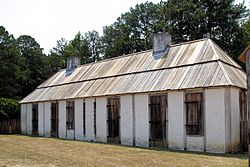Fort Toulouse
|
Fort Toulouse Site-Fort Jackson
|
|

A portion of the modern Fort Toulouse reconstruction, photo taken in 2007
|
|
| Location | Elmore County, Alabama, USA |
|---|---|
| Nearest city | Wetumpka, Alabama |
| Coordinates | 32°30′23.83″N 86°15′5.65″W / 32.5066194°N 86.2515694°WCoordinates: 32°30′23.83″N 86°15′5.65″W / 32.5066194°N 86.2515694°W |
| NRHP Reference # | 66000148 |
| Significant dates | |
| Added to NRHP | October 15, 1966 |
| Designated NHL | October 9, 1960 |
Fort Toulouse (Muscogee: Franca choka chula), also called Fort des Alibamons and Fort Toulouse des Alibamons, is a historic fort near the city of Wetumpka, Alabama, United States, that is now maintained by the Alabama Historical Commission. The French founded the fort in 1717, naming it for Louis-Alexandre de Bourbon, comte de Toulouse. In order to counter the growing influence of the British colonies of Georgia and Carolina, the government of French Louisiana erected a fort on the eastern border of the Louisiana Colony in what is now the state of Alabama.
The fort was also referred to as the Post of the Alabama, named after the Alabama tribe of Upper Creek Indians, who resided just below the confluence of the Coosa and Tallapoosa rivers on the upper reaches of the Alabama River.
The number of troops in garrison varied between 20 to 50 French Colonial Marines. Living and working at the fort, the Marines traded extensively with the local Creek Native Americans and cultivated friendly relations with them. The French would trade European goods such as Flintlock guns, ammunition, and gunpowder, iron tools, knives, glass beads, copper pots, and wool blankets in exchange for local food stuffs, fur and deerskins. According to tradition, the French commander Captain Jean Baptiste Louis DeCourtel Marchand married the high-status Creek woman Sehoy in about 1720. Later generations of Sehoy's descendants include the Creek chiefs Alexander McGillivray, and William Weatherford, who inherited their status in the matrilineal tribe from their mothers' clans.
...
Wikipedia


